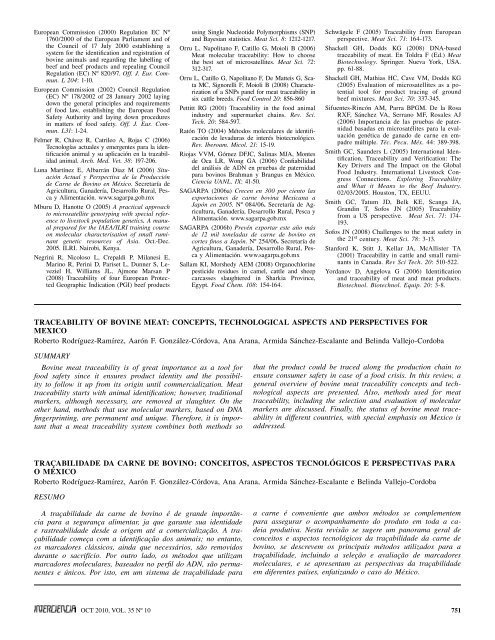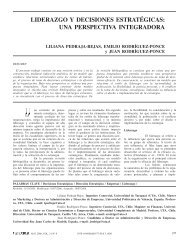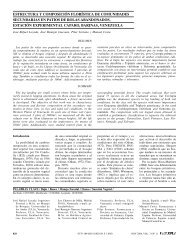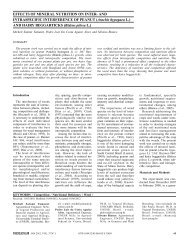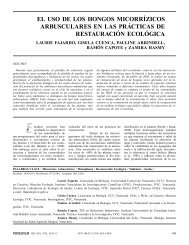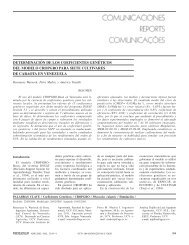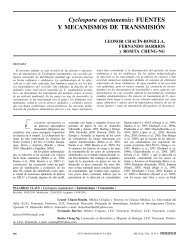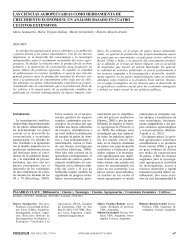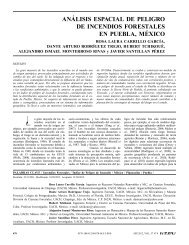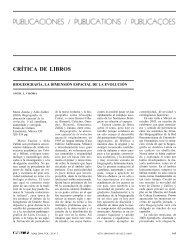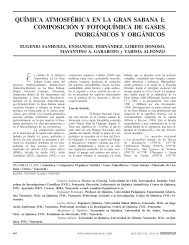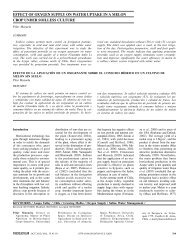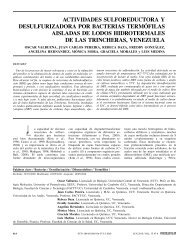TRAZABILIDAD DE LA CARNE DE BOVINO ... - Interciencia
TRAZABILIDAD DE LA CARNE DE BOVINO ... - Interciencia
TRAZABILIDAD DE LA CARNE DE BOVINO ... - Interciencia
You also want an ePaper? Increase the reach of your titles
YUMPU automatically turns print PDFs into web optimized ePapers that Google loves.
European Commission (2000) Regulation EC Nº<br />
1760/2000 of the European Parliament and of<br />
the Council of 17 July 2000 establishing a<br />
system for the identification and registration of<br />
bovine animals and regarding the labelling of<br />
beef and beef products and repealing Council<br />
Regulation (EC) Nº 820/97. Off. J. Eur. Commun.<br />
L 204: 1-10.<br />
European Commission (2002) Council Regulation<br />
(EC) Nº 178/2002 of 28 January 2002 laying<br />
down the general principles and requirements<br />
of food law, establishing the European Food<br />
Safety Authority and laying down procedures<br />
in matters of food safety. Off. J. Eur. Commun.<br />
L31: 1-24.<br />
Felmer R, Chávez R, Catrileo A, Rojas C (2006)<br />
Tecnologías actuales y emergentes para la identificación<br />
animal y su aplicación en la trazabilidad<br />
animal. Arch. Med. Vet. 38: 197-206.<br />
Luna Martínez E, Albarrán Diaz M (2006) Situación<br />
Actual y Perspectiva de la Producción<br />
de Carne de Bovino en México. Secretaría de<br />
Agricultura, Ganadería, Desarrollo Rural, Pesca<br />
y Alimentación. www.sagarpa.gob.mx<br />
Mburu D, Hanotte O (2005) A practical approach<br />
to microsatellite genotyping with special reference<br />
to livestock population genetics. A manual<br />
prepared for the IAEA/ILRI training course<br />
on molecular characterisation of small ruminant<br />
genetic resources of Asia. Oct.-Dec.<br />
2005. ILRI. Nairobi, Kenya.<br />
Negrini R, Nicoloso L, Crepaldi P, Milanesi E,<br />
Marino R, Perini D, Pariset L, Dunner S, Leveziel<br />
H, Williams JL, Ajmone Marsan P<br />
(2008) Traceability of four European Protected<br />
Geographic Indication (PGI) beef products<br />
using Single Nucleotide Polymorphisms (SNP)<br />
and Bayesian statistics. Meat Sci. 8: 1212-1217.<br />
Orru L, Napolitano F, Catillo G, Moioli B (2006)<br />
Meat molecular traceability: How to choose<br />
the best set of microsatellites. Meat Sci. 72:<br />
312-317.<br />
Orru L, Catillo G, Napolitano F, De Matteis G, Scata<br />
MC, Signorelli F, Moioli B (2008) Characterization<br />
of a SNPs panel for meat traceability in<br />
six cattle breeds. Food Control 20: 856-860<br />
Pettitt RG (2001) Traceability in the food animal<br />
industry and supermarket chains. Rev. Sci.<br />
Tech. 20: 584-597.<br />
Ratón TO (2004) Métodos moleculares de identificación<br />
de levaduras de interés biotecnológico.<br />
Rev. Iberoam. Micol. 21: 15-19.<br />
Riojas VVM, Gómez DFJC, Salinas MJA, Montes<br />
de Oca LR, Wong GA (2006) Confiabilidad<br />
del análisis de ADN en pruebas de paternidad<br />
para bovinos Brahman y Brangus en México.<br />
Ciencia UANL. IX: 41-50.<br />
SAGARPA (2006a) Crecen en 300 por ciento las<br />
exportaciones de carne bovina Mexicana a<br />
Japón en 2005. Nº 084/06. Secretaría de Agricultura,<br />
Ganadería, Desarrollo Rural, Pesca y<br />
Alimentación. www.sagarpa.gob.mx<br />
SAGARPA (2006b) Prevén exportar este año más<br />
de 12 mil toneladas de carne de bovino en<br />
cortes finos a Japón. Nº 254/06. Secretaría de<br />
Agricultura, Ganadería, Desarrollo Rural, Pesca<br />
y Alimentación. www.sagarpa.gob.mx<br />
Sallam KI, Morshedy AEM (2008) Organochlorine<br />
pesticide residues in camel, cattle and sheep<br />
carcasses slaughtered in Sharkia Province,<br />
Egypt. Food Chem. 108: 154-164.<br />
Schwägele F (2005) Traceability from European<br />
perspective. Meat Sci. 71: 164-173.<br />
Shackell GH, Dodds KG (2008) DNA-based<br />
traceability of meat. En Toldra F (Ed.) Meat<br />
Biotechnology. Springer. Nueva York, USA.<br />
pp. 61-88.<br />
Shackell GH, Mathias HC, Cave VM, Dodds KG<br />
(2005) Evaluation of microsatellites as a potential<br />
tool for product tracing of ground<br />
beef mixtures. Meat Sci. 70: 337-345.<br />
Sifuentes-Rincón AM, Parra BPGM. De la Rosa<br />
RXF, Sánchez VA, Serrano MF, Rosales AJ<br />
(2006) Importancia de las pruebas de paternidad<br />
basadas en microsatélites para la evaluación<br />
genética de ganado de carne en empadre<br />
múltiple. Téc. Pecu. Méx. 44: 389-398.<br />
Smith GC, Saunders L (2005) International Identification,<br />
Traceability and Verification: The<br />
Key Drivers and The Impact on the Global<br />
Food Industry. International Livestock Congress<br />
Connections. Exploring Traceability<br />
and What it Means to the Beef Industry.<br />
02/03/2005. Houston, TX, EEUU.<br />
Smith GC, Tatum JD, Belk KE, Scanga JA,<br />
Grandin T, Sofos JN (2005) Traceability<br />
from a US perspective. Meat Sci. 71: 174-<br />
193.<br />
Sofos JN (2008) Challenges to the meat safety in<br />
the 21 st century. Meat Sci. 78: 3-13.<br />
Stanford K, Stitt J, Kellar JA, McAllister TA<br />
(2001) Traceability in cattle and small ruminants<br />
in Canada. Rev Sci Tech. 20: 510-522.<br />
Yordanov D, Angelova G (2006) Identification<br />
and traceability of meat and meat products.<br />
Biotechnol. Biotechnol. Equip. 20: 3-8.<br />
TRACEABILITY OF BOVINE MEAT: CONCEPTS, TECHNOLOGICAL ASPECTS AND PERSPECTIVES FOR<br />
MEXICO<br />
Roberto Rodríguez-Ramírez, Aarón F. González-Córdova, Ana Arana, Armida Sánchez-Escalante and Belinda Vallejo-Cordoba<br />
SUMMARY<br />
Bovine meat traceability is of great importance as a tool for<br />
food safety since it ensures product identity and the possibility<br />
to follow it up from its origin until commercialization. Meat<br />
traceability starts with animal identification; however, traditional<br />
markers, although necessary, are removed at slaughter. On the<br />
other hand, methods that use molecular markers, based on DNA<br />
fingerprinting, are permanent and unique. Therefore, it is important<br />
that a meat traceability system combines both methods so<br />
that the product could be traced along the production chain to<br />
ensure consumer safety in case of a food crisis. In this review, a<br />
general overview of bovine meat traceability concepts and technological<br />
aspects are presented. Also, methods used for meat<br />
traceability, including the selection and evaluation of molecular<br />
markers are discussed. Finally, the status of bovine meat traceability<br />
in different countries, with special emphasis on Mexico is<br />
addressed.<br />
TRAÇABILIDA<strong>DE</strong> DA <strong>CARNE</strong> <strong>DE</strong> <strong>BOVINO</strong>: CONCEITOS, ASPECTOS TECNOLÓGICOS E PERSPECTIVAS PARA<br />
O MÉXICO<br />
Roberto Rodríguez-Ramírez, Aarón F. González-Córdova, Ana Arana, Armida Sánchez-Escalante e Belinda Vallejo-Cordoba<br />
RESUMO<br />
A traçabilidade da carne de bovino é de grande importância<br />
para a segurança alimentar, ja que garante sua identidade<br />
e rastreabilidade desde a origem até a comercialização. A traçabilidade<br />
começa com a identificação dos animais; no entanto,<br />
os marcadores clássicos, ainda que necessários, são removidos<br />
durante o sacrifício. Por outro lado, os métodos que utilizam<br />
marcadores moleculares, baseados no perfil do ADN, são permanentes<br />
e únicos. Por isto, em um sistema de traçabilidade para<br />
a carne é conveniente que ambos métodos se complementem<br />
para assegurar o acompanhamento do produto em toda a cadeia<br />
produtiva. Nesta revisão se sugere um panorama geral de<br />
conceitos e aspectos tecnológicos da traçabilidade da carne de<br />
bovino, se descrevem os principais métodos utilizados para a<br />
traçabilidade, incluindo a seleção e avaliação de marcadores<br />
moleculares, e se apresentam as perspectivas da traçabilidade<br />
em diferentes países, enfatizando o caso do México.<br />
OCT 2010, VOL. 35 Nº 10 751


